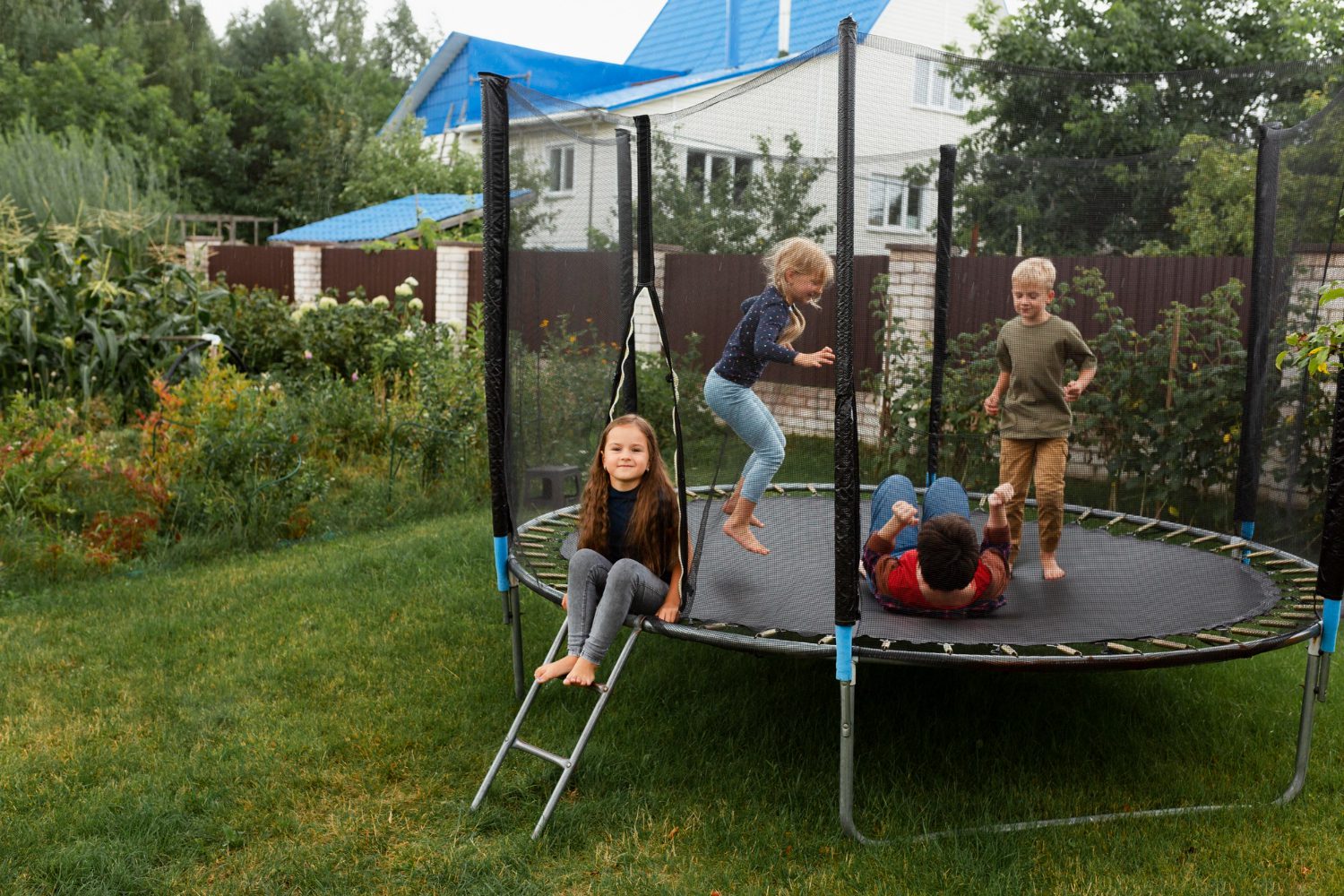When summer arrives, families naturally look for ways to spend more time outdoors, stay active and enjoy the fresh air together. Yet in an era of screens and sedentary habits, keeping children (and parents) moving can be a real challenge. One simple yet powerful solution has been gaining popularity across Europe – the backyard trampoline. Far from being just a toy for children, a trampoline is an excellent tool for physical exercise, emotional wellbeing and family bonding. It is a source of fun, fitness and togetherness – all in one.
Why a trampoline is more than just play
Most people associate trampolines with childhood play, but in reality, they offer far greater benefits. Jumping is an incredibly effective form of exercise, activating almost every muscle group while being gentle on the joints. Unlike jogging or cycling, trampoline workouts rely on vertical motion, which strengthens the core, improves balance and develops coordination. For children, this means better motor skills and body awareness; for adults, it’s a refreshing and low-impact way to stay fit.
On a psychological level, trampolining stimulates the release of endorphins – the so-called “happiness hormones.” These natural mood boosters help reduce stress and anxiety, creating an overall sense of wellbeing. Parents often notice that after a few minutes of jumping, their children are calmer, more focused and in a better mood. This is not just playtime – it’s emotional regulation through joyful movement. According to sports psychologist Dr. Emily Watkins from the University of Leeds, “Trampoline activity engages both the body and the brain, providing a balanced combination of physical exertion and emotional release.”
How a trampoline can unite the family
One of the greatest strengths of a backyard trampoline is its ability to bring people together. Instead of watching television or scrolling on phones, families can share moments of laughter and light exercise outdoors. Parents can join children for gentle stretching, warm-ups or even light cardio sessions on the trampoline. This shared activity not only improves health but also strengthens emotional bonds.
When movement becomes part of family life, it naturally creates a healthier lifestyle. Even 10–15 minutes of trampoline activity a day can significantly improve cardiovascular health, balance and energy levels. For children, it’s an excellent way to burn off energy and reduce screen time. For parents, it’s a convenient alternative to gym workouts – available just a few steps from the kitchen door. Dr. Robert Hall, a family health specialist from the American College of Sports Medicine, emphasizes that “shared physical activities, like jumping on a trampoline, help families develop not just physical strength, but also emotional closeness.”
Choosing the right trampoline for your family
Before purchasing a trampoline, it’s essential to consider who will be using it and how much space you have. For families with young children, safety should always come first. Choose a model with a strong protective net, padded edges and a low frame for easier access. The trampoline should have a durable, weather-resistant surface and a sturdy frame – ideally made from galvanized steel – to ensure long-term stability.
If your family includes older children or you plan to join the fun yourself, consider a larger trampoline that allows for more space and movement. Pay attention to the weight capacity to avoid overstressing the springs and frame. Many modern trampolines come with extra features such as zippered safety enclosures, non-slip ladders and UV-resistant nets – all designed to enhance safety and comfort.
A quality trampoline is an investment in your family’s wellbeing. It is worth spending a little more on a model that will last several seasons, withstand various weather conditions and keep everyone safe. Regularly check the frame, mat and netting for wear, and store it properly during the colder months.
Practical advice and safety tips
Although trampolining is generally safe, there are a few common mistakes that can lead to injuries or reduce the equipment’s lifespan. To enjoy trampoline time safely, specialists recommend following these essential steps:
- Always ensure that only one person jumps at a time to prevent collisions.
- Remove shoes, jewelry and sharp objects before jumping.
- Install a protective net and inspect it regularly for damage.
- Keep the trampoline on a flat, stable surface away from trees or fences.
- Supervise children at all times, especially if they are under 10 years old.
According to European safety standards (EN 71-14), trampolines must be tested for frame strength and net resistance. Research by the European Sports Equipment Association (2023) found that correctly installed trampolines reduce the risk of accidents by up to 45%. Another frequent error is neglecting regular maintenance. Weather and constant use can weaken the springs or loosen the frame. Establishing clear rules with children about safe behavior can make trampoline time both fun and responsible.
Turning trampoline time into a healthy habit
The real magic happens when jumping on the trampoline becomes part of the family’s daily or weekly routine. Even 10 minutes of moderate bouncing can burn calories, improve lymphatic circulation and boost the immune system. For children, it helps develop strong bones and muscles, while for adults it offers an enjoyable way to relieve stress and stay active. “Rebounding, as it’s known in fitness science, can increase cardiovascular endurance by 12% within eight weeks,” notes Dr. Lisa Moreno, a lecturer in sports physiology at the University of Copenhagen.
To make trampoline time a lasting habit, schedule it just like any other activity. Set aside time after dinner or during weekend mornings for family jumping sessions. Combine fun with fitness – for example, try counting jumps, playing “copy my move,” or using a timer for short, energetic challenges. Over time, this simple activity can transform your yard into the family’s favorite fitness space. Consistency is the key to making any family activity truly beneficial.
- Set specific trampoline days to establish routine.
- Track progress and make it a friendly family competition.
- Encourage laughter and creativity during play.
- Use music or challenges to make it more dynamic.
Building healthier family traditions
A trampoline in the backyard is much more than a seasonal attraction – it’s a tool that helps create meaningful family moments and encourages an active lifestyle. In today’s fast-paced digital age, finding ways to disconnect from screens and reconnect with loved ones is invaluable. Jumping together becomes a ritual that strengthens both body and spirit.
The best family memories are often made through shared laughter and movement. Whether it’s a spontaneous weekend activity, a structured fitness routine or simply a few minutes of fun after work, a trampoline helps turn ordinary days into joyful experiences. Professor Anna Blake, a behavioral health researcher from King’s College London, explains, “Families that regularly engage in shared physical activity demonstrate 30% higher emotional cohesion and overall wellbeing.”
Summary
A backyard trampoline is not merely a piece of sports equipment – it’s a source of joy, exercise and family connection. It encourages children to spend more time outdoors, improves coordination and boosts physical and emotional health. By choosing a safe, high-quality model and establishing simple rules, families can enjoy years of safe and fun activity. A trampoline can transform your backyard into a space of energy, laughter and wellbeing – the perfect balance between play and health.
In short, if you’re looking for a way to motivate your family to move more, smile more and spend more quality time together, a trampoline might be the most rewarding investment you can make. It’s not just play – it’s a lifestyle upgrade. As family therapist Dr. Hannah Keller concludes, “Shared joy is the foundation of emotional connection, and few activities deliver it as simply and effectively as jumping together under the open sky.”




